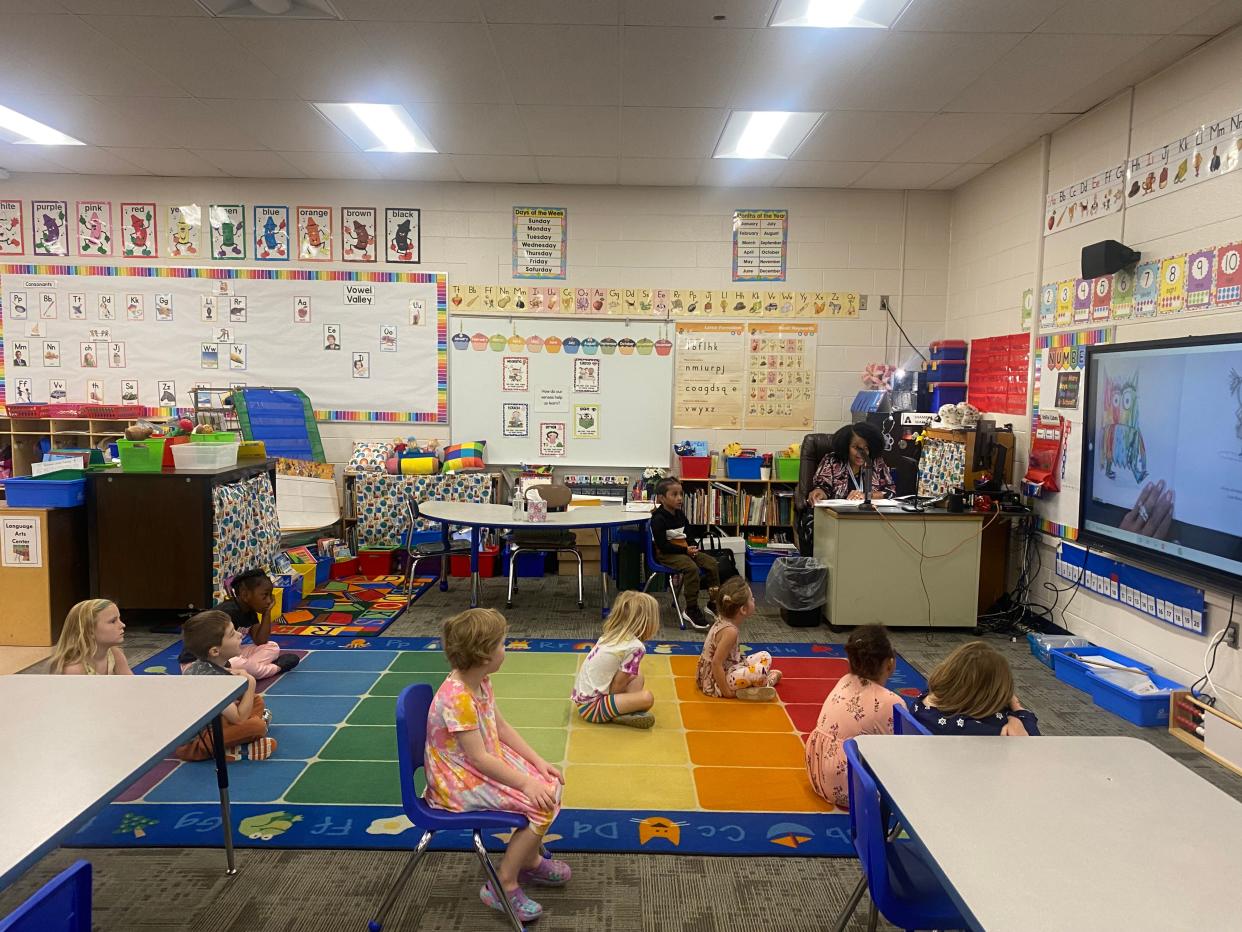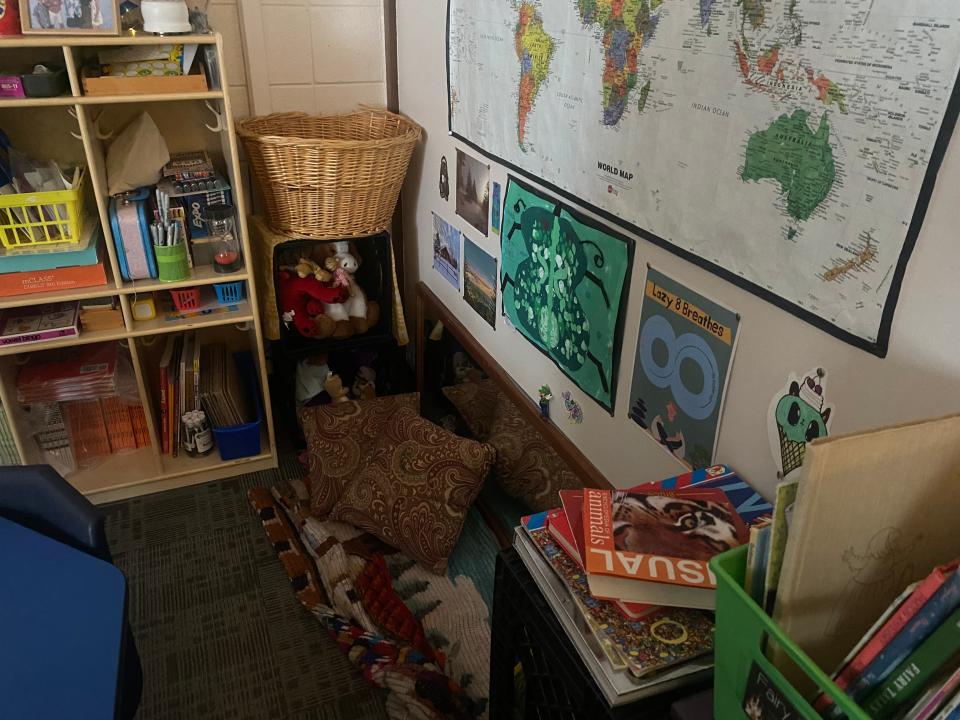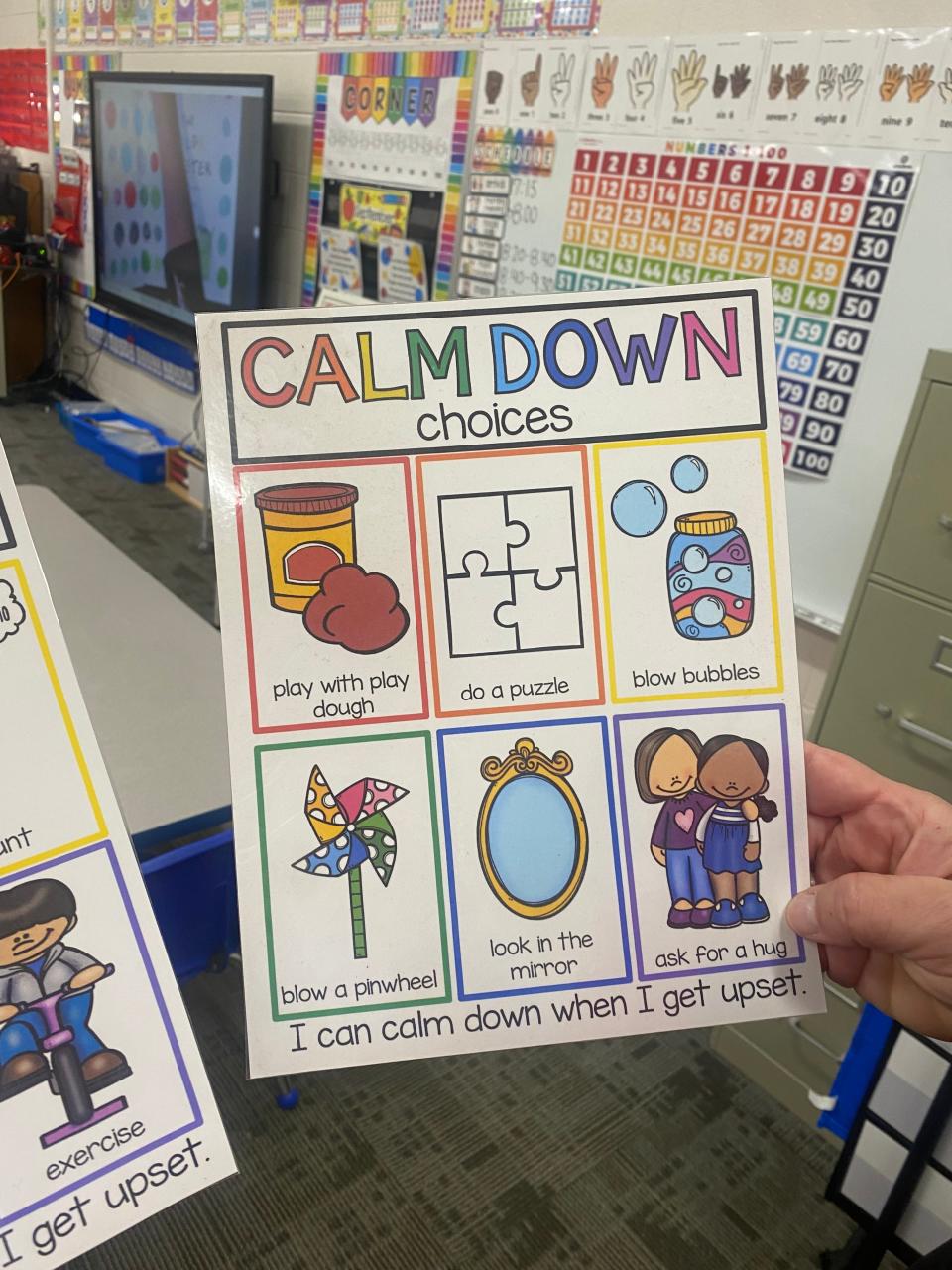Social-emotional learning in Asheville City Schools; How does it impact students?

ASHEVILLE - Marianne Simmons' first-grade students at Hall Fletcher Elementary start their days off by singing.
"Good morning, good morning, it's a good, good, good, good morning, we say hello and how do you do to all our friends and teachers, too," students sing together at their morning circle time on a recent September Thursday.
At the other end of the building is Shambra Watkins kindergarten class, reading "The Color Monster: A Story About Emotions," identifying what being happy and sad looks like and how both emotions are OK.
Watkins asked her kindergarten class, "Where do you go when you need to calm down?"

The children pointed to the "safe place," a cozy spot in the room that students can go if they are having "big emotions," Watkins said.
Asheville City Schools middle and elementary students start their day off with a social-emotional learning lesson. This can look like a reading lesson, singing a song and telling stories, or getting to know one another. Each elementary classroom spends the first 20 to 30 minutes a day on it.
At Asheville Middle School, it is called "advisory" period, where students spend the first 15 minutes of their day four times out of the week on a social-emotional lesson.
The high schools added a fifth period this year, which is 50 minutes long and they take this time to focus on SEL. The period was added to provide additional academic and social-emotional support to all students, also giving them time to participate in clubs that don't require them to meet outside of school, according to ACS Spokesperson, Dillon Huffman.
More: Answer Woman: Why are Asheville High class times so long? Same in Buncombe County schools?
Jesus Citalan-Angeles' seventh-grade classroom got to know one another a bit more on the morning of Sept. 15 ― connecting by sharing their birthdays. With only eight students in the class, they went around the room, holding a stuffed animal when it was their turn to talk, and shared when their birthday was. Other classmates had to write the date down in their own agendas.
"It's to build community and connection. This is a designated time every single day for teachers to set aside the academic curriculum and build on the social-emotional curriculum and connect with kids, to also create a sense of belonging," seventh-grade Assistant Principal of AMS Brian Powchak told the Citizen Times Sept. 15.
Social and emotional learning is nothing new in classrooms, Tima Williams, director of social-emotional learning at ACS said, but since the COVID pandemic people are talking about it more because of the loss of connection that took place during 2020 and even the years following.

Asheville City Schools social-emotional learning vision states: "We work together with intentionality to create a sense of belonging in our school community."
Williams said that ACS partners with mental health therapists to provide services for students, and some will provide them in-person on campus.
"I know, there's a lot of conversation about social emotional learning and some confusion or missed conceptions about what that actually means. Here in Asheville City Schools, we are preparing our educators and our students to be good citizens," Williams told the Citizen Times.
Each elementary school has one counselor, Asheville Middle School has three counselors, one for each grade level. Asheville High has four counselors while SILSA and Montford have one.
There are currently 550 students enrolled at Asheville Middle School, and Asheville High has 1,200 students.
More: What is Buncombe County NC Child data on health, food insecurity, reading, family income?
'Pull away' from academic learning?
Critics of this curriculum say that it takes away from valuable academic learning time, but educators say it helps build relationships and trust within the classroom.
Stephanie Carson, a parent of a middle schooler and high schooler at ACS said that in theory social emotional learning sounds like a great idea.
"I feel like in practice there's just more of a pull away from academic time and wasted time in the classroom because what's supposed to be happening during that time is not necessarily happening depending on the teacher," Carson told the Citizen Times Sept. 15.
"The achievement gap in Asheville City Schools is a huge problem."
In Asheville City Schools, only 11% of Black students grades three to eight were considered proficient in math in the 2021-22 school year based on end-of-year standardized tests, compared to the 66% of white students who were considered proficient. That's a 55 percentage point gap.
The same gap was present in reading scores as well, where 13% of Black students in the same grades were considered proficient in reading, compared to 75% of white students, coming out to a 62 percentage point gap.
More: My Daddy Taught Me That will pay Asheville kids to go to school this summer
The North Carolina Department of Public Instruction put together a state board of education strategic plan to help improve school and district performance by 2025 and SEL is closely aligned with this plan, the NCDPI website says.
Kathleen King, a parent of a kindergartner and second grader at Isaac Dickson Elementary, told the Citizen Times Sept. 15 that talking about emotions is something she does at home with her children and she's glad the school is reinforcing that.
"Learning to get along with others and be a part of a community is important in schools. I think a big part of that is learning how to regulate our emotions," King said.
The NCDPI says that the research done around SEL indicates that one of the benefits is an increase in academic performance.
"An important thing for all of us to remember is that social emotional learning doesn't happen overnight. This is going to be year over year improvement, and probably the most benefit that we'll see from them implementing this starts with the kids in elementary school right now," Carson said.
Chelsey Gaddy, director of musical theatre at Mars Hill University and a parent of a Buncombe Schools student, told the Citizen Times Sept. 14 that she can tell when her students have been exposed to SEL versus when they haven't.
"It facilitates responsible decision making," Gaddy said.
"I've had to alter my teaching over the last few years. The generation of folks coming through can't really make decisions for themselves. It's almost like there's a complete lack of curiosity, because they're afraid to fail, they don't feel like they know themselves well enough to be able to fail and then fail better."
More: Asheville City, Buncombe County schools performance grades are in for 2022-23 year
More: Asheville City Schools Board passes anti-racist statement; public comment emotions high
McKenna Leavens is the education reporter for the Asheville Citizen Times, part of the USA Today Network. Email her at mleavens@citizentimes.com or follow her on Twitter @LeavensMcKennna. Please support this type of journalism with a subscription to the Citizen Times.
This article originally appeared on Asheville Citizen Times: Social emotional learning how does it benefit Asheville students
